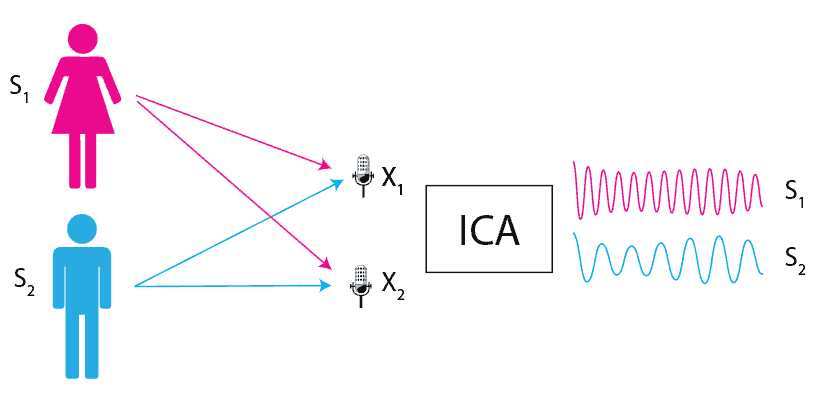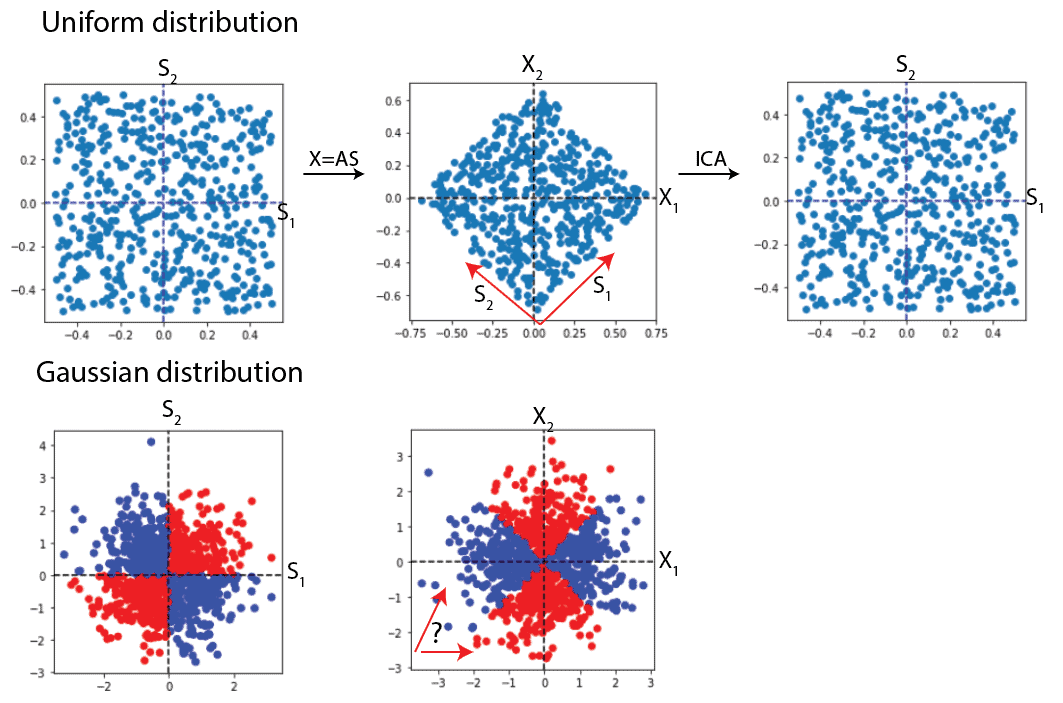1. 简介
独立成分分析(Independent Component Analysis,简称 ICA)是一种用于信号处理和机器学习的强大统计方法。它的核心目标是从一组混合信号中恢复出原始的、相互独立的信号源。例如,当我们面对多个声音源混合在一起的场景时,ICA 可以帮助我们从中分离出每个声音源的原始信号。
本文将通过“鸡尾酒会问题”来解释 ICA 的基本原理,介绍其数学定义、关键假设、常用算法以及典型应用场景。
2. 鸡尾酒会问题
ICA 最经典的使用场景之一是“鸡尾酒会问题”。假设在一个聚会中,有两个人在同时讲话,而我们放置了两个麦克风来记录他们的声音。由于距离不同,两个麦克风记录到的两人声音比例不同,同时还夹杂着环境噪音。
我们的目标是:从这两个混合信号中分离出两个原始说话人的声音。

这个问题看似复杂,但正是 ICA 擅长解决的类型。
3. 独立成分分析的定义
ICA 的核心思想是:将一个多元信号分解为多个相互独立的子成分。换句话说,它试图找到一个变换矩阵,使得变换后的信号尽可能地相互独立。
设我们有观测信号 ,它们是多个源信号
的线性组合:
(1)
其中 是混合系数。
反过来,我们可以用观测信号来估计源信号:
(2)
其中 是权重。
用矩阵形式表示为:
$$ S = WX $$
其中 是我们需要求解的权重矩阵。
ICA 的目标就是:找到这样一个 ,使得
之间的独立性最大化。
最大化独立性通常可以通过以下两种方式实现:
✅ 最小化各成分之间的互信息
✅ 最大化各成分的非高斯性
3.1. ICA 的前提假设
要成功应用 ICA,必须满足以下三个前提条件:
- 每个观测信号都是源信号的线性组合
- 各源信号之间是统计独立的
- 每个源信号的分布是非高斯的
统计独立性的定义如下:
两个信号 和
是统计独立的,当且仅当其联合分布等于各自分布的乘积:
(3)
根据中心极限定理,两个随机变量的线性组合会比原始变量更接近高斯分布。因此,如果源信号本身是高斯分布的,它们的混合也会是高斯的,从而无法从中恢复出原始信号。

因此,ICA 要求源信号具有非高斯分布。
4. ICA 常用算法
为了估计一个源信号,我们通常考虑观测信号 的线性组合,记为:
(4)
其中 是权重向量。
定义 ,则有:
(5)
根据中心极限定理, 比任何
更接近高斯分布,除非它恰好等于某个
。
因此,最大化 的非高斯性,就能得到一个独立成分。
衡量非高斯性的常用指标之一是峰度(kurtosis)。峰度反映了一个分布相对于高斯分布的“尖锐”或“平坦”程度。当峰度为零时,分布为高斯分布;正峰度表示分布更尖锐,负峰度表示更平坦。
因此,我们可以通过最大化峰度的绝对值来优化:
(6)
常见 ICA 算法
- FastICA:一种基于非线性优化的迭代算法,常用于快速求解 ICA 问题
- Infomax:通过最大化混合信号与估计信号之间的互信息来求解
- JADE(联合近似对角化特征矩阵):利用四阶矩来分离信号
- PSO(粒子群优化):一种启发式优化算法,用于搜索最佳混合矩阵
在使用这些算法之前,通常需要对数据进行中心化和白化处理,以提高算法的稳定性和收敛速度。
5. ICA 的应用场景
ICA 在多个领域都有广泛的应用,主要包括:
✅ 语音与音频信号分离:如从混音中分离出人声和背景音乐
✅ 神经科学:从脑电图(EEG)或功能磁共振成像(fMRI)数据中提取大脑活动的独立成分
✅ 金融分析:识别金融时间序列中的隐藏特征,用于预测或风险评估
✅ 数据挖掘:在大数据集中发现隐藏的模式和相关性
6. 总结
本文通过“鸡尾酒会问题”介绍了 ICA 的基本思想,阐述了其数学定义、核心假设和常用算法。ICA 是一种强大的信号处理工具,能够从混合信号中提取出原始独立成分,在语音处理、神经科学、金融分析等领域具有广泛应用。
掌握 ICA 的原理和使用方法,有助于我们在实际项目中处理复杂的信号分离问题。